曼昆经济学原理第3、4篇练习
经济学原理曼昆课后答案chapter4
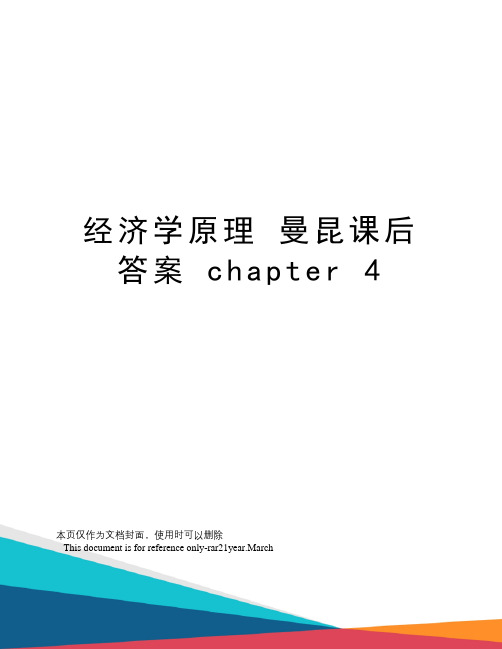
经济学原理曼昆课后答案c h a p t e r4本页仅作为文档封面,使用时可以删除This document is for reference only-rar21year.MarchProblems and Applications1. a. Cold weather damages the orange crop, reducing the supply of oranges.This can be seen in Figure 4-6 as a shift to the left in the supply curve fororanges. The new equilibrium price is higher than the old equilibriumprice.Figure 4-6b. People often travel to the Caribbean from New England to escape coldweather, so demand for Caribbean hotel rooms is high in the winter. Inthe summer, fewer people travel to the Caribbean, since northern climesare more pleasant. The result, as shown in Figure 4-7, is a shift to the leftin the demand curve. The equilibrium price of Caribbean hotel rooms isthus lower in the summer than in the winter, as the figure shows.Figure 4-7c. When a war breaks out in the Middle East, many markets are affected.Since much oil production takes place there, the war disrupts oil supplies, shifting the supply curve for gasoline to the left, as shown in Figure 4-8.The result is a rise in the equilibrium price of gasoline. With a higherprice for gasoline, the cost of operating a gas-guzzling automobile, like aCadillac, will increase. As a result, the demand for used Cadillacs willdecline, as people in the market for cars won't find Cadillacs as attractive.In addition, some people who already own Cadillacs will try to sell them.The result is that the demand curve for used Cadillacs shifts to the left,while the supply curve shifts to the right, as shown in Figure 4-9. Theresult is a decline in the equilibrium price of used Cadillacs.Figure 4-8Figure 4-92. The statement that "an increase in the demand for notebooks raises the quantityof notebooks demanded, but not the quantity supplied" is false, in general. AsFigure 4-10 shows, the increase in demand for notebooks results in an increased quantity supplied. The only way the statement would be true is if the supplycurve were perfectly inelastic, as shown in Figure 4-11.Figure 4-10Figure 4-113. a. If people decide to have more children (a change in tastes), they'll wantlarger vehicles for hauling their kids around, so the demand for minivanswill increase. Supply won't be affected. The result is a rise in both priceand quantity, as Figure 4-12 shows.Figure 4-12Figure 4-13b. If a strike by steelworkers raises steel prices, the costs of producing aminivan rise (a rise in input prices), so the supply of minivans decreases.Demand won't be affected. The result is a rise in the price of minivansand a decline in the quantity, as Figure 4-13 shows.c. The development of new automated machinery for the production ofminivans is an improvement in technology. The reduction in firms' costsresults in an increase in supply. Demand isn't affected. The result is a decline in the price of minivans and an increase in the quantity, as Figure 4-14shows.Figure 4-14Figure 4-15d. The rise in the price of station wagons affects minivan demand becausestation wagons are substitutes for minivans (that is, there's a rise in theprice of a related good). The result is an increase in demand for minivans.Supply isn't affected. In equilibrium, the price and quantity of minivansboth rise, as Figure 4-12 shows.e. The reduction in peoples' wealth caused by a stock-market crash reducestheir income, leading to a reduction in the demand for minivans, sinceminivans are a normal good. Supply isn’t affected. As a result, both priceand quantity decline, as Figure 4-15 shows.4. Technological advances that reduce the cost of producing computer chipsrepresent a decline in an input price for producing a computer. The result is ashift to the right in the supply of computers, as shown in Figure 4-16. Theequilibrium price falls and the equilibrium quantity rises, as the figure shows.Figure 4-16Figure 4-17Since computer software is a complement to computers, the increasedequilibriumquantity of computers increases the demand for software. As Figure 4-17 shows, the result is a rise in both the equilibrium price and quantity of software.Since typewriters are substitutes for computers, the increased equilibriumquantity of computers reduces the demand for typewriters. As Figure 4-18shows, the result is a decline in both the equilibrium price and quantity oftypewriters.Figure 4-185. a. When a hurricane in South Carolina damages the cotton crop, it raisesinput prices for producing sweatshirts. As a result, the supply ofsweatshirts shifts to the left, as shown in Figure 4-19. The newequilibrium has a higher price and lower quantity of sweatshirts.b. A decline in the price of leather jackets leads more people to buy leatherjackets, reducing the demand for sweatshirts. The result, shown in Figure 4-20, is a decline in both the equilibrium price and quantity of sweatshirts.Figure 4-20c. The effects of colleges requiring students to engage in morningcalisthenics in appropriate attire raises the demand for sweatshirts, asshown in Figure 4-21. The result is an increase in both the equilibriumprice and quantity of sweatshirts.d. The invention of new knitting machines increases the supply ofsweatshirts. As Figure 4-22 shows, the result is a reduction in theequilibrium price and an increase in the equilibrium quantity ofsweatshirts.Figure 4-226. A temporarily high birth rate in the year 2005 leads to opposite effects on theprice of babysitting services in the years 2010 and 2020. In the year 2010, there are more 5-year olds who need sitters, so the demand for babysitting servicesrises, as shown in Figure 4-23. The result is a higher price for babysitting services in 2010. However, in the year 2020, the increased number of 15-year olds shifts the supply of babysitting services to the right, as shown in Figure 4-24. Theresult is a decline in the price of babysitting services.Figure 4-23Figure 4-247. Since ketchup is a complement for hot dogs, when the price of hot dogs rises,the quantity demanded of hot dogs falls, thus reducing the demand for ketchup, causing both price and quantity of ketchup to fall. Since the quantity of ketchup falls, the demand for tomatoes by ketchup producers falls, so both price andquantity of tomatoes fall. When the price of tomatoes falls, producers of tomato juice face lower input prices, so the supply curve for tomato juice shifts down,causing the price of tomato juice to fall and the quantity of tomato juice to rise.The fall in the price of tomato juice causes people to substitute tomato juice for orange juice, so the demand for orange juice declines, causing the price andquantity of orange juice to fall. Now you can see clearly why a rise in the price ofhot dogs leads to a fall in price of orange juice!Figure 4-258. a. Cigars and chewing tobacco are substitutes for cigarettes, since a higherprice for cigarettes would increase demand for cigars and chewingtobacco.b. An increase in the tax on cigarettes leads to increased demand for cigarsand chewing tobacco. The result, as shown in Figure 4-25 for cigars, is arise in both the equilibrium price and quantity of cigars and chewingtobacco.c. The results in part (b) showed that a tax on cigarettes leads people tosubstitute cigars and chewing tobacco for cigarettes when the tax oncigarettes rises. To reduce total tobacco usage, policymakers might alsowant to increase the tax on cigars and chewing tobacco, or pursue sometype of public education program.9. Quantity supplied equals quantity demanded at a price of $6 and quantity of 81pizzas (Figure 4-26). If price were greater than $6, quantity supplied wouldexceed quantity demanded, so suppliers would reduce their price to gain sales.If price were less than $6, quantity demanded would exceed quantity supplied, so suppliers could raise their price without losing sales. In both cases, the price would continue to adjust until it reached $6, the only price at which there'sneither surplus nor shortage.Figure 4-2610. a. If the price of flour falls, since flour is an ingredient in bagels, the supplycurve for bagels would shift to the right. The result, shown in Figure 4-27,would be a fall in the price of bagels and a rise in the equilibrium quantityof bagels.Since cream cheese is a complement to bagels, the rise in quantitydemanded of bagels increases the demand for cream cheese, as shown inFigure 4-28. The result is a rise in both the equilibrium price and quantityof cream cheese. So, a fall in the price of flour indeed raises both theequilibrium price of cream cheese and the equilibrium quantity of bagels.Figure 4-27Figure 4-28What happens if the price of milk falls Since milk is an ingredient in cream cheese, the fall in the price of milk leads to an increase in the supply of cream cheese. This leads to a decrease in the price of cream cheese (Figure 4-29), rather than a rise in the price of cream cheese. So a fall in the price of milk couldn't have been responsible for the pattern observed.Figure 4-29Figure 4-30b. In part (a), we found that a fall in the price of flour led to a rise in theprice of cream cheese and a rise in the equilibrium quantity of bagels. Ifthe price of flour rose, the opposite would be true; it would lead to a fallin the price of cream cheese and a fall in the equilibrium quantity ofbagels. Since the question says the equilibrium price of cream cheese has risen, it couldn't have been caused by a rise in the price of flour.What happens if the price of milk rises From part (a), we found that a fallin the price of milk caused a decline in the price of cream cheese, so arise in the price of milk would cause a rise in the price of cream cheese.Since bagels and cream cheese are complements, the rise in the price ofcream cheese would reduce the demand for bagels, as Figure 4-30 shows.The result is a decline in the equilibrium quantity of bagels. So a rise inthe price of milk does cause both a rise in the price of cream cheese anda decline in the equilibrium quantity of bagels.11. a. As Figure 4-31 shows, the supply curve is vertical. The constant supplymakes sense because the basketball arena has a fixed number of seats nomatter what the price.Figure 4-31b. Quantity supplied equals quantity demanded at a price of $8. Theequilibrium quantity is 8,000 tickets.c.Price Quantity Demanded Quantity Supplied$ 4 14,0008,0008 11,0008,000128,0008,000165,0008,000202,0008,000The new equilibrium price will be $12, which equates quantity demandedto quantity supplied. The equilibrium quantity is 8,000 tickets.12. The executives are confusing changes in demand with changes in quantitydemanded. Figure 4-32 shows the demand curve prior to the marketing campaign (D1), and after the campaign (D2). The marketing campaign increased the demand for champagne, as shown, leading to a higher equilibrium price and quantity. Theinfluence of the higher price on demand is already reflected in the outcome. It's impossible for the scenario outlined by the executives to occur.Figure 4-32。
曼昆《经济学原理(微观经济学分册)》(第6版)课后习题详解(第3章 相互依存性与贸易的好处)
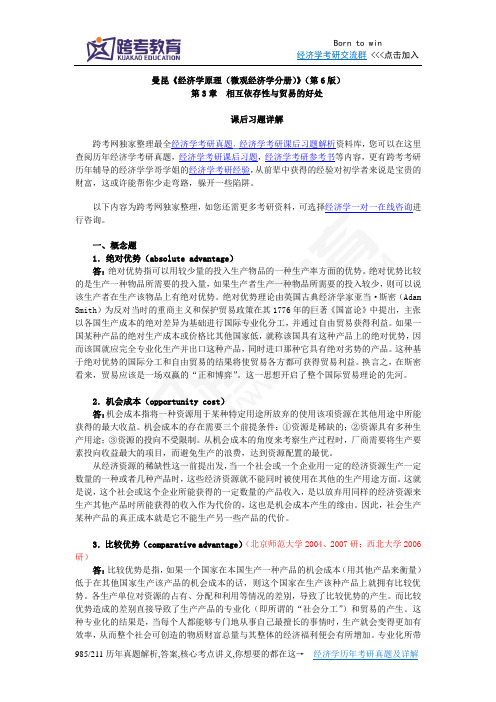
曼昆《经济学原理(微观经济学分册)》(第6版)第3章相互依存性与贸易的好处课后习题详解跨考网独家整理最全经济学考研真题,经济学考研课后习题解析资料库,您可以在这里查阅历年经济学考研真题,经济学考研课后习题,经济学考研参考书等内容,更有跨考考研历年辅导的经济学学哥学姐的经济学考研经验,从前辈中获得的经验对初学者来说是宝贵的财富,这或许能帮你少走弯路,躲开一些陷阱。
以下内容为跨考网独家整理,如您还需更多考研资料,可选择经济学一对一在线咨询进行咨询。
一、概念题1.绝对优势(absolute advantage)答:绝对优势指可以用较少量的投入生产物品的一种生产率方面的优势。
绝对优势比较的是生产一种物品所需要的投入量,如果生产者生产一种物品所需要的投入较少,则可以说该生产者在生产该物品上有绝对优势。
绝对优势理论由英国古典经济学家亚当·斯密(Adam Smith)为反对当时的重商主义和保护贸易政策在其1776年的巨著《国富论》中提出,主张以各国生产成本的绝对差异为基础进行国际专业化分工,并通过自由贸易获得利益。
如果一国某种产品的绝对生产成本或价格比其他国家低,就称该国具有这种产品上的绝对优势,因而该国就应完全专业化生产并出口这种产品,同时进口那种它具有绝对劣势的产品。
这种基于绝对优势的国际分工和自由贸易的结果将使贸易各方都可获得贸易利益。
换言之,在斯密看来,贸易应该是一场双赢的“正和博弈”。
这一思想开启了整个国际贸易理论的先河。
2.机会成本(opportunity cost)答:机会成本指将一种资源用于某种特定用途所放弃的使用该项资源在其他用途中所能获得的最大收益。
机会成本的存在需要三个前提条件:①资源是稀缺的;②资源具有多种生产用途;③资源的投向不受限制。
从机会成本的角度来考察生产过程时,厂商需要将生产要素投向收益最大的项目,而避免生产的浪费,达到资源配置的最优。
从经济资源的稀缺性这一前提出发,当一个社会或一个企业用一定的经济资源生产一定数量的一种或者几种产品时,这些经济资源就不能同时被使用在其他的生产用途方面。
曼昆经济学原理(第四版)课后习题中文答案(7)[小编整理]
![曼昆经济学原理(第四版)课后习题中文答案(7)[小编整理]](https://img.taocdn.com/s3/m/e9749001a4e9856a561252d380eb6294dd882223.png)
曼昆经济学原理(第四版)课后习题中文答案(7)[小编整理]第一篇:曼昆经济学原理(第四版)课后习题中文答案(7)图 26-4 政府借款对可贷资金市场的影响由于可贷资金的供给弹性衡量可贷资金供给量对利率变化的反应程度,所以它反映在可贷资金供给曲线的形状上。
当可贷资供给弹性大时,即可贷资金供给曲线平缓,在这种情况下,当市场利率上升时,可贷资金供给量会大量增加,尤其是私人储蓄,因为公共储蓄由政府收入和政府支出决定,所以公共储蓄不变,国民储蓄会大量增加。
(见图a)当可贷资金供给弹性小时,既可贷资金供给曲线陡峭,在这种情况下,当市场利率大幅度上升时,可贷资金供给没有增加多少,尤其是私人储蓄没有大量增加,因为公共储蓄不受利率的影响,因此,国民储蓄没有增加多少。
(见图 b)D.可贷资金需求弹性如何影响这些变动的大小? 答:当可贷资金的需求弹性大时,政府借款增加200 亿美元引起的利率上升会挤出大量的投资。
当可贷资金的需求弹性小时,政府借款的增加只会减少小部分私人投资。
(a)可贷资金需求弹性大(b)可贷资金需求弹性小图 26-5 可贷资金需求弹性对可贷资金市场的影响E.假设家庭相信,政府现在借款越多意味着未来为了偿还政府债务而必须征收的税收越高。
这种信念对私人储蓄和现在可贷资金的供给有什么影响?这种信念加强还是减弱了你在 A 与 B 中所讨论的影响? 答:为了偿还现在积累的债务,政府将要在未来增加税收,这种信念会使家庭认为减税并没有减少家庭的整体税单,它仅仅是延期而已。
因此家庭会把所有的减税储蓄起来,而不是支出其中一部分,因而会使私人储蓄增加。
由于私人储蓄增加量完全等于公共储蓄减少量,作为公共和私人储蓄之和的国民储蓄并没有变,因此可贷资金的供给没有变。
这种信念减弱了 A 与 B 中所讨论的影响。
9.过去的十年间,新电脑技术使企业大大减少了它们每销售一美元所持有的存货量。
说明这种变化对可贷资金市场的影响。
(提示:用于存货的支出是一种投资。
曼昆宏观第3章课后复习规范标准答案
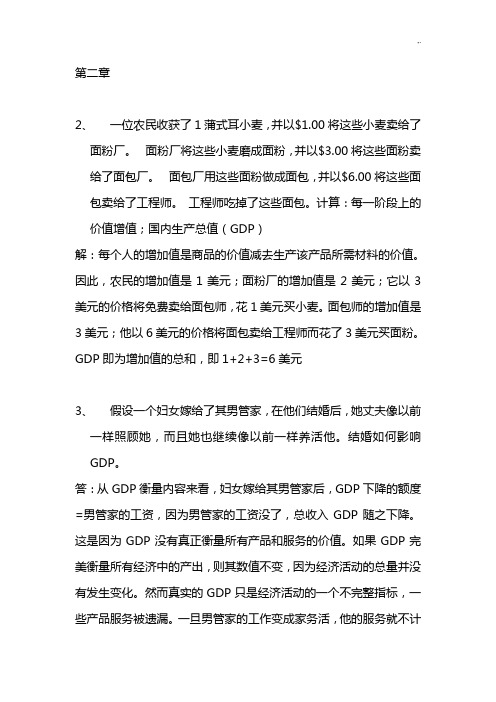
第二章2、一位农民收获了1蒲式耳小麦,并以$1.00将这些小麦卖给了面粉厂。
面粉厂将这些小麦磨成面粉,并以$3.00将这些面粉卖给了面包厂。
面包厂用这些面粉做成面包,并以$6.00将这些面包卖给了工程师。
工程师吃掉了这些面包。
计算:每一阶段上的价值增值;国内生产总值(GDP)解:每个人的增加值是商品的价值减去生产该产品所需材料的价值。
因此,农民的增加值是1美元;面粉厂的增加值是2美元;它以3美元的价格将免费卖给面包师,花1美元买小麦。
面包师的增加值是3美元;他以6美元的价格将面包卖给工程师而花了3美元买面粉。
GDP即为增加值的总和,即1+2+3=6美元3、假设一个妇女嫁给了其男管家,在他们结婚后,她丈夫像以前一样照顾她,而且她也继续像以前一样养活他。
结婚如何影响GDP。
答:从GDP衡量内容来看,妇女嫁给其男管家后,GDP下降的额度=男管家的工资,因为男管家的工资没了,总收入GDP随之下降。
这是因为GDP没有真正衡量所有产品和服务的价值。
如果GDP完美衡量所有经济中的产出,则其数值不变,因为经济活动的总量并没有发生变化。
然而真实的GDP只是经济活动的一个不完整指标,一些产品服务被遗漏。
一旦男管家的工作变成家务活,他的服务就不计入GDP。
6、考虑一个生产并消费面包和汽车的经济。
下表中是两个不同年份的数据。
(1)以2000年作为基年,计算每年的名义GDP,实际GDP,GDP 平减指数以及像CPI这样的固定加权物价指数。
解:名义GDP2000=(P汽车2000*Q汽车2000)+(P面包2000*Q面包2000)=10,000,000名义GDP2010=(P汽车2010*Q汽车2010)+(P面包2010*Q面包2010)=15,200,000实际GDP2010=(P汽车2000*Q汽车2010)+(P面包2000*Q面包2010)=10,000,0002010年隐含的价格平减指数=名义GDP2010/实际GDP2010*100=152CPI2010=[ P汽车2010*Q汽车2000)+(P面包2010*Q面包2000)]/[(P汽车2000*Q汽车2000)+(P面包2000*Q面包2000)]=1.6(2)在2000年到2010年之间,物价上涨了多少?比较拉斯拜尔指数和帕氏指数给出答案。
经济学原理 曼昆第五版英文答案Chapter34
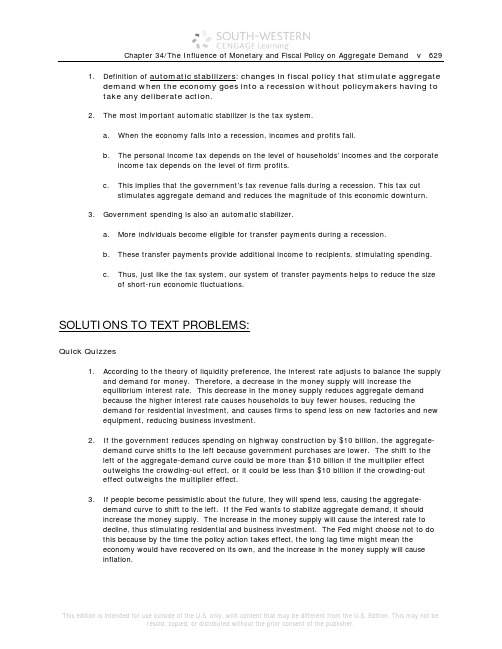
1. Definition of automatic stabilizers: changes in fiscal policy that stimulate aggregatedemand when the economy goes into a recession without policymakers having totake any deliberate action.2. The most important automatic stabilizer is the tax system.a. When the economy falls into a recession, incomes and profits fall.b. The personal income tax depends on the level of households’ incomes and the corporateincome tax depends on the level of firm profits.c. This implies that the government’s tax revenue falls during a recession. This tax cutstimulates aggregate demand and reduces the magnitude of this economic downturn.3. Government spending is also an automatic stabilizer.a. More individuals become eligible for transfer payments during a recession.b. These transfer payments provide additional income to recipients, stimulating spending.c. Thus, just like the tax system, our system of transfer payments helps to reduce the sizeof short-run economic fluctuations.SOLUTIONS TO TEXT PROBLEMS:Quick Quizzes1. According to the theory of liquidity preference, the interest rate adjusts to balance the supplyand demand for money. Therefore, a decrease in the money supply will increase theequilibrium interest rate. This decrease in the money supply reduces aggregate demandbecause the higher interest rate causes households to buy fewer houses, reducing thedemand for residential investment, and causes firms to spend less on new factories and newequipment, reducing business investment.2. If the government reduces spending on highway construction by $10 billion, the aggregate-demand curve shifts to the left because government purchases are lower. The shift to theleft of the aggregate-demand curve could be more than $10 billion if the multiplier effectoutweighs the crowding-out effect, or it could be less than $10 billion if the crowding-outeffect outweighs the multiplier effect.3. If people become pessimistic about the future, they will spend less, causing the aggregate-demand curve to shift to the left. If the Fed wants to stabilize aggregate demand, it shouldincrease the money supply. The increase in the money supply will cause the interest rate todecline, thus stimulating residential and business investment. The Fed might choose not to dothis because by the time the policy action takes effect, the long lag time might mean theeconomy would have recovered on its own, and the increase in the money supply will causeinflation.1. The theory of liquidity preference is Keynes's theory of how the interest rate is determined.According to the theory, the aggregate-demand curve slopes downward because: (1) ahigher price level raises money demand; (2) higher money demand leads to a higher interest rate; and (3) a higher interest rate reduces the quantity of goods and services demanded.Thus, the price level has a negative relationship with the quantity of goods and servicesdemanded.2. A decrease in the money supply shifts the money-supply curve to the left. The equilibriuminterest rate will rise. The higher interest rate reduces consumption and investment, soaggregate demand falls. Thus, the aggregate-demand curve shifts to the left.3. If the government spends $3 billion to buy police cars, aggregate demand might increase bymore than $3 billion because of the multiplier effect on aggregate demand. Aggregatedemand might increase by less than $3 billion because of the crowding-out effect onaggregate demand.4. If pessimism sweeps the country, households reduce consumption spending and firms reduceinvestment, so aggregate demand falls. If the Fed wants to stabilize aggregate demand, it must increase the money supply, reducing the interest rate, which will induce households to save less and spend more and will encourage firms to invest more, both of which willincrease aggregate demand. If the Fed does not increase the money supply, Congress could increase government purchases or reduce taxes to increase aggregate demand.5. Government policies that act as automatic stabilizers include the tax system and governmentspending through the unemployment-benefit system. The tax system acts as an automatic stabilizer because when incomes are high, people pay more in taxes, so they cannot spend as much. When incomes are low, so are taxes; thus, people can spend more. The result is that spending is partly stabilized. Government spending through the unemployment-benefit system acts as an automatic stabilizer because in recessions the government transfers money to the unemployed so their incomes do not fall as much and thus their spending will not fall as much.1. a. When more ATMs are available, money demand is reduced and the money-demand curveshifts to the left from MD1 to MD2, as shown in Figure 6. If the Fed does not change the money supply, which is at MS1, the interest rate will decline from r1 to r2. The decline inthe interest rate shifts the aggregate-demand curve to the right, as consumption andinvestment increase.b. If the Fed wants to stabilize aggregate demand, it should reduce the money supply to MS, so the interest rate will remain at r1 and aggregate demand will not change.22. a. When the Fed’s bond traders buy bonds in open-market operations, the money-supplycurve shifts to the right from MS1 to MS2, as shown in Figure 1. The result is a decline in the interest rate.Figure 1Figure 2b. When an increase in credit card availability reduces the cash people hold, the money-demand curve shifts to the left from MD1 to MD2, as shown in Figure 2. The result is a decline in the interest rate.c. When the Federal Reserve reduces reserve requirements, the money supply increases, sothe money-supply curve shifts to the right from MS1 to MS2, as shown in Figure 1. The result is a decline in the interest rate.d. When households decide to hold more money to use for holiday shopping, the money-demand curve shifts to the right from MD1 to MD2, as shown in Figure 3. The result is a rise in the interest rate.Figure 3e. When a wave of optimism boosts business investment and expands aggregate demand,money demand increases from MD1 to MD2 in Figure 3. The increase in money demand increases the interest rate.Figure 43. a. The increase in the money supply will cause the equilibrium interest rate to decline, asshown in Figure 4. Households will increase spending and will invest in more new housing. Firms too will increase investment spending. This will cause the aggregate demand curve to shift to the right as shown in Figure 5.Price LevelQuantity of Output P 1AD 1AD 2P 2Y 1Y 2Short-run Aggregate SupplyFigure 5b. As shown in Figure 5, the increase in aggregate demand will cause an increase in bothoutput and the price level in the short run.c. When the economy makes the transition from its short-run equilibrium to its long-runequilibrium, short-run aggregate supply will decline, causing the price level to rise even further. d. The increase in the price level will cause an increase in the demand for money, raisingthe equilibrium interest rate.e. Yes. While output initially rises because of the increase in aggregate demand, it will fallonce short-run aggregate supply declines. Thus, there is no long-run effect of the increase in the money supply on real output.Figure 64. A tax cut that is permanent will have a bigger impact on consumer spending and aggregatedemand. If the tax cut is permanent, consumers will view it as adding substantially to their financial resources, and they will increase their spending substantially. If the tax cut istemporary, consumers will view it as adding just a little to their financial resources, so they will not increase spending as much. 5. a. The current situation is shown in Figure 7.Price LevelQuantity of OutputShort-run Aggregate Suppl yAggregate DemandLong-run Aggregate Suppl yFigure 7b. The Fed will want to stimulate aggregate demand. Thus, it will need to lower the interestrate by increasing the money supply. This could be achieved if the Fed purchases government bonds from the public.Figure 8c. As shown in Figure 8, the Fed's purchase of government bonds shifts the supply ofmoney to the right, lowering the interest rate.d. The Fed's purchase of government bonds will increase aggregate demand as consumersand firms respond to lower interest rates. Output and the price level will rise as shown in Figure 9.Figure 96. a. Legislation allowing banks to pay interest on checking deposits increases the return tomoney relative to other financial assets, thus increasing money demand.b. If the money supply remained constant (at MS1), the increase in the demand for moneywould have raised the interest rate, as shown in Figure 10. The rise in the interest ratewould have reduced consumption and investment, thus reducing aggregate demand and output.c. To maintain a constant interest rate, the Fed would need to increase the money supplyfrom MS1 to MS2. Then aggregate demand and output would be unaffected.Figure 107. a. If there is no crowding out, then the multiplier equals 1/(1 – MPC). Because themultiplier is 3, then MPC = 2/3.b. If there is crowding out, then the MPC would be larger than 2/3. An MPC that is largerthan 2/3 would lead to a larger multiplier than 3, which is then reduced down to 3 by the crowding-out effect.8. a. The initial effect of the tax reduction of $20 billion is to increase aggregate demand by$20 billion x 3/4 (the MPC) = $15 billion.b. Additional effects follow this initial effect as the added incomes are spent. The secondround leads to increased consumption spending of $15 billion x 3/4 = $11.25 billion. The third round gives an increase in consumption of $11.25 billion x 3/4 = $8.44 billion. The effects continue indefinitely. Adding them all up gives a total effect that depends on the multiplier. With an MPC of 3/4, the multiplier is 1/(1 – 3/4) = 4. So the total effect is $15 billion x 4 = $60 billion.c. Government purchases have an initial effect of the full $20 billion, because they increaseaggregate demand directly by that amount. The total effect of an increase in government purchases is thus $20 billion x 4 = $80 billion. So government purchases lead to a bigger effect on output than a tax cut does. The difference arises because governmentpurchases affect aggregate demand by the full amount, but a tax cut is partly saved byconsumers, and therefore does not lead to as much of an increase in aggregate demand.d. The government could increase taxes by the same amount it increases its purchases.9. a. If the marginal propensity to consume is 0.8, the spending multiplier will be 1/(1-0.8) =5. Therefore, the government would have to increase spending by $400/5 = $80 billionto close the recessionary gap.b. With an MPC of 0.8, the tax multiplier is (0.8)(1/(1-0.8)) = (0.8)(5) = 4. Therefore, thegovernment would need to cut taxes by $400 billion/4 = $100 billion to close therecessionary gap.c. If the central bank was to hold the money supply constant, my answer would be largerbecause crowding out would occur.d. They would have to raise both government spending and taxes by $400 billion. Theincrease in government purchases would result in a boost of $2,000 billion, while thehigher taxes would reduce spending by $1,600 billion. This leaves a $400 billion rise inaggregate spending.10. If government spending increases, aggregate demand rises, so money demand rises. Theincrease in money demand leads to a rise in the interest rate and thus a decline in aggregate demand if the Fed does not respond. But if the Fed maintains a fixed interest rate, it will increase money supply, so aggregate demand will not decline. Thus, the effect on aggregate demand from an increase in government spending will be larger if the Fed maintains a fixed interest rate.11. a. Expansionary fiscal policy is more likely to lead to a short-run increase in investment ifthe investment accelerator is large. A large investment accelerator means that theincrease in output caused by expansionary fiscal policy will induce a large increase ininvestment. Without a large accelerator, investment might decline because the increase in aggregate demand will raise the interest rate.b. Expansionary fiscal policy is more likely to lead to a short-run increase in investment ifthe interest sensitivity of investment is small. Because fiscal policy increases aggregatedemand, thus increasing money demand and the interest rate, the greater the sensitivity of investment to the interest rate the greater the decline in investment will be, which will offset the positive accelerator effect.12. a. Tax revenue declines when the economy goes into a recession because taxes are closelyrelated to economic activity. In a recession, people's incomes and wages fall, as do firms' profits, so taxes on these things decline.b. Government spending rises when the economy goes into a recession because morepeople get unemployment-insurance benefits, welfare benefits, and other forms ofincome support.c. If the government were to operate under a strict balanced-budget rule, it would have toraise tax rates or cut government spending in a recession. Both would reduce aggregate demand, making the recession more severe.13. a. If there were a contraction in aggregate demand, the Fed would need to increase themoney supply to increase aggregate demand and stabilize the price level, as shown inFigure 11. By increasing the money supply, the Fed is able to shift the aggregate-demand curve back to AD1 from AD2. This policy stabilizes output and the price level.Figure 11b. If there were an adverse shift in short-run aggregate supply, the Fed would need todecrease the money supply to stabilize the price level, shifting the aggregate-demand curve to the left from AD1 to AD2, as shown in Figure 12. This worsens the recession caused by the shift in aggregate supply. To stabilize output, the Fed would need to increase the money supply, shifting the aggregate-demand curve from AD1 to AD3.However, this action would raise the price level.Figure 12。
曼昆经济学原理 第五版 课后答案 第三篇 供给与需求
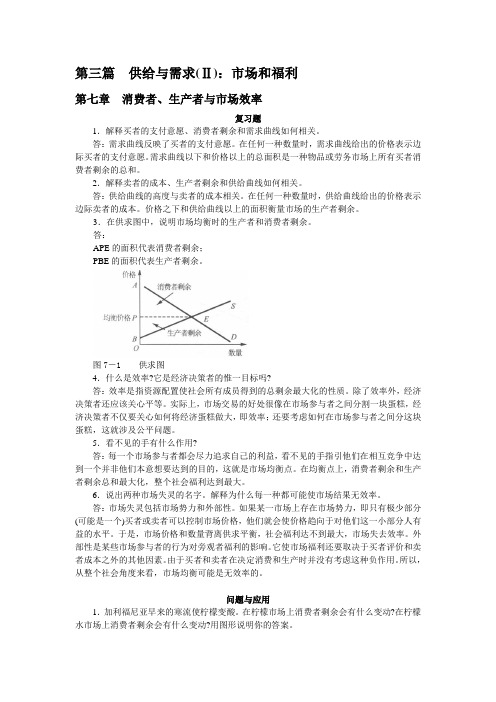
第三篇供给与需求(Ⅱ):市场和福利第七章消费者、生产者与市场效率复习题1.解释买者的支付意愿、消费者剩余和需求曲线如何相关。
答:需求曲线反映了买者的支付意愿。
在任何一种数量时,需求曲线给出的价格表示边际买者的支付意愿。
需求曲线以下和价格以上的总面积是一种物品或劳务市场上所有买者消费者剩余的总和。
2.解释卖者的成本、生产者剩余和供给曲线如何相关。
答:供给曲线的高度与卖者的成本相关。
在任何一种数量时,供给曲线给出的价格表示边际卖者的成本。
价格之下和供给曲线以上的面积衡量市场的生产者剩余。
3.在供求图中,说明市场均衡时的生产者和消费者剩余。
答:APE的面积代表消费者剩余;PBE的面积代表生产者剩余。
图7-1 供求图4.什么是效率?它是经济决策者的惟一目标吗?答:效率是指资源配置使社会所有成员得到的总剩余最大化的性质。
除了效率外,经济决策者还应该关心平等。
实际上,市场交易的好处很像在市场参与者之间分割一块蛋糕,经济决策者不仅要关心如何将经济蛋糕做大,即效率;还要考虑如何在市场参与者之间分这块蛋糕,这就涉及公平问题。
5.看不见的手有什么作用?答:每一个市场参与者都会尽力追求自己的利益,看不见的手指引他们在相互竞争中达到一个并非他们本意想要达到的目的,这就是市场均衡点。
在均衡点上,消费者剩余和生产者剩余总和最大化,整个社会福利达到最大。
6.说出两种市场失灵的名字。
解释为什么每一种都可能使市场结果无效率。
答:市场失灵包括市场势力和外部性。
如果某一市场上存在市场势力,即只有极少部分(可能是一个)买者或卖者可以控制市场价格,他们就会使价格趋向于对他们这一小部分人有益的水平。
于是,市场价格和数量背离供求平衡,社会福利达不到最大,市场失去效率。
外部性是某些市场参与者的行为对旁观者福利的影响。
它使市场福利还要取决于买者评价和卖者成本之外的其他因素。
由于买者和卖者在决定消费和生产时并没有考虑这种负作用。
所以,从整个社会角度来看,市场均衡可能是无效率的。
曼昆宏观经济经济学第九版英文原版答案3

曼昆宏观经济经济学第九版英文原版答案3Answers to Textbook Questions and ProblemsCHAPTER 3 National Income: Where It Comes From and Where It GoesQuestions for Review1. The factors of production and the production technologydetermine the amount of output an economy can produce. The factors of production are the inputs used to produce goods and services: the most important factors are capital and labor. The production technology determines how much output can be produced from any given amounts of these inputs. An increase in one of the factors of production or an improvement in technology leads to an increase in the economy’s output.2. When a firm decides how much of a factor of production tohire or demand, it considers how this decision affects profits. For example, hiring an extra unit of labor increases output and therefore increases revenue; the firm compares this additional revenue to the additional cost from the higher wage bill. The additional revenue the firm receives depends on the marginal product of labor (MPL) and the price of the good produced (P). An additional unit of labor produces MPL units of additional output, which sells for P dollars per unit. Therefore, the additional revenue to the firm is P MPL. The cost of hiring the additional unit of labor is the wage W. Thus, this hiring decision has the following effect on profits:ΔProfit= ΔRevenue –ΔCost= (P MPL) –W.If the additional revenue, P MPL, exceeds the cost (W) ofhiring the additional unit of labor, then profit increases. The firm will hire labor until it is no longer profitable to do so—that is, until the MPL falls to the point where the change in profit is zero. In the equation abov e, the firm hires labor until ΔP rofit = 0, which is when (P MPL) = W.This condition can be rewritten as:MPL = W/P.Therefore, a competitive profit-maximizing firm hires labor until the marginal product of labor equals the real wage.The same logic applies to the firm’s decision regarding how much capital to hire: the firm will hire capital until the marginal product of capital equals the real rental price.3. A production function has constant returns to scale if anequal percentage increase in all factors of production causes an increase in output of the same percentage. For example, if a firm increases its use of capital and labor by 50 percent, and output increases by 50 percent, then the production function has constant returns to scale.If the production function has constant returns to scale,then total income (or equivalently, total output) in an economy of competitive profit-maximizing firms is divided between the return to labor, MPL L, and the return to capital, MPK K. That is, under constant returns to scale, economic profit is zero.4. A Cobb–Douglas production function has the form F(K,L) =AKαL1–α. The text showed that the parameter αgives capital’s share of income. So if capital earns one-fourth of total income, then = . Hence, F(K,L) = Consumption depends positively on disposable income—.the amount of income after all taxes have been paid. Higherdisposable income means higher consumption.The quantity of investment goods demanded depends negatively on the real interest rate. For an investment to be profitable, its return must be greater than its cost.Because the real interest rate measures the cost of funds,a higher real interest rate makes it more costly to invest,so the demand for investment goods falls.6. Government purchases are a measure of the value of goodsand services purchased directly by the government. For example, the government buys missiles and tanks, builds roads, and provides services such as air traffic control.All of these activities are part of GDP. Transfer payments are government payments to individuals that are not in exchange for goods or services. They are the opposite of taxes: taxes reduce household disposable income, whereas transfer payments increase it. Examples of transfer payments include Social Security payments to the elderly, unemployment insurance, and veterans’ benefits.7. Consumption, investment, and government purchases determinedemand for the economy’s output, whereas the factors of production and the production function determine the supply of output. The real interest rate adjusts to ensure that the demand for the economy’s goods equals th e supply. At the equilibrium interest rate, the demand for goods and services equals the supply.8. When the government increases taxes, disposable incomefalls, and therefore consumption falls as well. The decrease in consumption equals the amount that taxes increase multipliedby the marginal propensity to consume (MPC). The higher the MPC is, the greater is the negative effect of the tax increase on consumption. Because output is fixed by the factors of production and the production technology, and government purchases have not changed, the decrease in consumption must be offset by an increase in investment. For investment to rise, the real interest rate must fall. Therefore, a tax increase leads to a decrease in consumption, an increase in investment, and a fall in the real interest rate.Problems and Applications1. a. According to the neoclassical theory of distribution,the real wage equals the marginal product of labor.Because of diminishing returns to labor, an increase in the labor force causes the marginal product of labor to fall. Hence, the real wage falls.Given a Cobb–Douglas production function, theincrease in the labor force will increase the marginal product of capital and will increase the real rental price of capital. With more workers, the capital will be used more intensively and will be more productive.b. The real rental price equals the marginal product ofcapital. If an earthquake destroys some of the capital stock (yet miraculously does not kill anyone and lower the labor force), the marginal product of capital rises and, hence, the real rental price rises.Given a Cobb–Douglas production function, the decrease in the capital stock will decrease the marginal product of labor and will decrease the real wage. With less capital, each worker becomes less productive.c. If a technological advance improves the productionfunction, this is likely to increase the marginal products of both capital and labor. Hence, the real wage and the real rental price both increase.d. High inflation that doubles the nominal wage and theprice level will have no impact on the real wage.Similarly, high inflation that doubles the nominal rental price of capital and the price level will have no impact on the real rental price of capital.2. a. To find the amount of output produced, substitute thegiven values for labor and land into the production function: Y = = 100.b. According to the text, the formulas for the marginalproduct of labor and the marginal product of capital (land) are:MPL = (1 –α)AKαL–α.MPK = αAKα–1L1–α.In this problem, αis and A is 1. Substitute in the given values for labor and land to find the marginal product of labor is and marginal product of capital (land) is . We know that the real wage equals the marginal product of labor and the real rental price of land equals the marginal product of capital (land).c. Labor’s share of the output is given by the marginalproduct of labor times the quantity of labor, or 50.d. The new level of output is .e. The new wage is . The new rental price of land is .f. Labor now receives .3. A production function has decreasing returns to scale if anequal percentage increase in all factors of production leads to a smaller percentage increase in output. For example, if we double the amounts of capital and labor output increases by lessthan double, then the production function has decreasing returns to scale. This may happen if there is a fixed factor such as land in the production function, and this fixed factor becomes scarce as the economy grows larger.A production function has increasing returns to scale ifan equal percentage increase in all factors of production leads to a larger percentage increase in output. For example, if doubling the amount of capital and labor increases the output by more than double, then the production function has increasing returns to scale. This may happen if specialization of labor becomes greater as the population grows. For example, if only one worker builds a car, then it takes him a long time because he has to learn many different skills, and he must constantly change tasks and tools. But if many workers build a car, then each one can specialize in a particular task and become more productive.4. a. A Cobb–Douglas production function has the form Y =AKαL1–α. The text showed that the marginal products for the Cobb–Douglas production function are:MPL = (1 –α)Y/L.MPK = αY/K.Competitive profit-maximizing firms hire labor until its marginal product equals the real wage, and hire capital until its marginal product equals the real rental rate. Using these facts and the above marginal products for the Cobb–Douglas production function, we find:W/P = MPL = (1 –α)Y/L.R/P = MPK = αY/K.Rewriting this:(W/P)L = MPL L = (1 –α)Y.(R/P)K = MPK K = αY.Note that the terms (W/P)L and (R/P)K are the wage bill and total return to capital, respectively. Given that the value of α= , then the above formulas indicate that labor receives 70 percent of total output (or income) and capital receives 30 percent of total output (or income).b. To determine what happens to total output when the laborforce increases by 10 percent, consider the formula for the Cobb–Douglas production function:Y = AKαL1–α.Let Y1equal the initial value of output and Y2equal final output. We know that α = . We also know that labor L increases by 10 percent:Y1 = Y2 = .Note that we multiplied L by to reflect the 10-percent increase in the labor force.To calculate the percentage change in output, divide Y2 by Y1:Y 2 Y 1=AK0.31.1L()0.7AK0.3L0.7 =1.1()0.7=1.069.That is, output increases by percent.To determine how the increase in the labor force affects the rental price of capital, consider the formula for the real rental price of capital R/P:R/P = MPK = αAKα–1L1–α.We know that α= . We also know that labor (L) increases by10 percent. Let (R/P)1equal the initial value of the rental price of capital, and let (R/P)2 equal the final rental price of capital after the laborforce increases by 10 percent. To find (R/P )2, multiply Lby to reflect the 10-percent increase in the labor force:(R/P )1 = – (R/P )2 = –.The rental price increases by the ratioR /P ()2R /P ()1=0.3AK -0.71.1L ()0.70.3AK -0.7L 0.7=1.1()0.7=1.069So the rental price increases by percent. To determine how the increase in the labor forceaffects the real wage, consider the formula for the real wage W/P :W/P = MPL = (1 –α)AK αL –α.We know that α = . We also know that labor (L )increases by 10 percent. Let (W/P )1 equal the initialvalue of the real wage, and let (W/P )2 equal the finalvalue of the real wage. To find (W/P )2, multiply L by toreflect the 10-percent increase in the labor force:(W/P )1 = (1 ––.(W/P )2 = (1 ––.To calculate the percentage change in the real wage, divide (W/P )2 by (W/P )1:W /P ()2W /P ()1=1-0.3()AK 0.31.1L ()-0.31-0.3()AK 0.3L -0.3=1.1()-0.3=0.972That is, the real wage falls by percent.c. We can use the same logic as in part (b) to setY 1 = Y 2 = A Therefore, we have:Y 2Y 1=A 1.1K ()0.3L 0.7AK 0.3L 0.7=1.1()0.3=1.029This equation shows that output increases by about 3percent. Notice that α < means that proportional increases to capital will increase output by less than the same proportional increase to labor.Again using the same logic as in part (b) for thechange in the real rental price of capital:R /P ()2R /P ()1=0.3A 1.1K ()-0.7L 0.70.3AK -0.7L 0.7=1.1()-0.7=0.935The real rental price of capital falls by percentbecause there are diminishing returns to capital; that is, when capital increases, its marginal product falls. Finally, the change in the real wage is:W /P ()2W /P ()1=0.7A 1.1K ()0.3L -0.30.7AK 0.3L -0.3=1.1()0.3=1.029Hence, real wages increase by percent because the addedcapital increases the marginal productivity of the existing workers. (Notice that the wage and output have both increased by the same amount, leaving the labor share unchanged —a feature of Cobb –Douglas technologies.)d. Using the same formula, we find that the change in output is:Y 2Y 1= 1.1A ()K 0.3L 0.7AK 0.3L 0.7=1.1This equation shows that output increases by 10 percent.Similarly, the rental price of capital and the real wage also increase by 10 percent:R /P ()2R /P ()1=0.31.1A ()K -0.7L 0.70.3AK -0.7L 0.7=1.1W /P ()2W /P ()1=0.71.1A ()K 0.3L -0.30.7AK 0.3L -0.3=1.15. Labor income is defined asW P ′L =WL P Labor’s share of income is defined asWL P ?è÷÷/Y =WL PY For example, if this ratio is aboutconstant at a value of ,then the value of W /P = *Y /L . This means that the real wage is roughly proportional to labor productivity. Hence, any trend in labor productivity must be matched by an equal trend in real wages. O therwise, labor’s share would deviate from . Thus, the first fact (a constant labor share) implies the second fact (the trend in real wages closely tracks the trend in labor productivity).6. a. Nominal wages are measured as dollars per hour worked.Prices are measured as dollars per unit produced (either a haircut or a unit of farm output). Marginal productivity is measured as units of output produced per hour worked.b. According to the neoclassical theory, technicalprogress that increases the marginal product of farmers causes their real wage to rise. The real wage for farmers is measured as units of farm output per hour worked. The real wage is W/P F, and this is equal to ($/hour worked)/($/unit of farm output).c. If the marginal productivity of barbers is unchanged,then their real wage is unchanged. The real wage for barbers is measured as haircuts per hour worked. The real wage is W/P B, and this is equal to ($/hour worked)/($/haircut).d. If workers can move freely between being farmers andbeing barbers, then they must be paid the same wage W in each sector.e. If the nominal wage W is the same in both sectors, butthe real wage in terms of farm goods is greater than the real wage in terms of haircuts, then the price of haircuts must have risen relative to the price of farm goods. We know that W/P = MPL so that W = P MPL. This means that P F MPL F= P H MPL B, given that the nominal wages are the same. Since the marginalproduct of labor for barbers has not changed and the marginal product of labor for farmers has risen, the price of a haircut must have risen relative to the price of the farm output. If we express this in growth rate terms, then the growth of the farm price + the growth of the marginal product of the farm labor = the growth of the haircut price.f. The farmers and the barbers are equally well off after the technological progress in farming, giventhe assumption that labor is freely mobile between the two sectors and both types of people consume the same basket of goods. Given that the nominal wage ends up equal for each type of worker and that they pay the same prices for final goods, they are equally well off in terms of what they can buy with their nominal income.The real wage is a measure of how many units of output are produced per worker. Technological progress in farming increased the units of farm output produced per hour worked. Movement of labor between sectors then equalized the nominal wage.7. a. The marginal product of labor (MPL)is found bydifferentiating the production function with respect to labor: MPL=dY dL=11/3H1/3L-2/3An increase in human capital will increase the marginal product of labor because more human capital makes all the existing labor more productive.b. The marginal product of human capital (MPH)is found bydifferentiating the production function with respect to human capital:MPH=dY dH=13K1/3L1/3H-2/3An increase in human capital will decrease the marginal product of human capital because there are diminishing returns.c. The labor share of output is the proportion of outputthat goes to labor. The total amount of output that goes to labor is the real wage (which, under perfect competition, equals the marginal product of labor) times the quantity of labor. This quantity is divided by the total amount of output to compute the labor share:Labor Share=(13K1/3H1/3L-2/3)LK1/3H1/3L1/3=1 3We can use the same logic to find the human capital share: Human Capital Share=(13K1/3L1/3H-2/3)HK1/3H1/3L1/3=1 3so labor gets one-third of the output, and human capital gets one-third of the output. Since workers own their human capital (we hope!), it will appear that labor gets two-thirds of output.d. The ratio of the skilled wage to the unskilled wage is:Wskilled Wunskilled =MPL+MPHMPL=13K1/3L-2/3H1/3+13K1/3L1/3H-2/313K1/3L-2/3H1/3=1+LHNotice that the ratio is always greater than 1 because skilled workers get paid more than unskilled workers.Also, when H increases this ratio falls because the diminishing returns to human capital lower its return, while at the same time increasing the marginal product of unskilled workers.e. If more colleges provide scholarships, it will increaseH, and it does lead to a more egalitarian society. The policy lowers the returns to education, decreasing the gap between the wages of more and less educated workers.More importantly, the policy even raises the absolute wage of unskilled workers because their marginal product rises when the number of skilled workers rises.8. The effect of a government tax increase of $100 billion on(a) public saving, (b) private saving, and (c) nationalsaving can be analyzed by using the following relationships: National Saving = [Private Saving] + [Public Saving]= [Y –T –C(Y –T)] + [T –G]= Y –C(Y –T) –G.a. Public Saving—The tax increase causes a 1-for-1increase in public saving. T increases by $100 billion and, therefore, public saving increases by $100 billion.b. Private Saving—The increase in taxes decreasesdisposable income, Y –T, by $100 billion. Since the marginal propensity to consume (MPC) is , consumption falls by $100 billion, or $60 billion. Hence,ΔPrivate Saving = –$100b – (–$100b) = –$40b.Private saving falls $40 billion.c. National Saving—Because national saving is the sum ofprivate and public saving, we can conclude that the $100 billion tax increase leads to a $60 billion increase in national saving.Another way to see this is by using the third equation for national saving expressed above, that national saving equals Y –C(Y –T) –G. The $100 billion tax increase reduces disposable income and causes consumption to fall by $60 billion. Since neither G nor Y changes, national saving thus rises by $60 billion.d. Investment—T o determine the effect of the tax increaseon investment, recall the national accounts identity:Y = C(Y –T) + I(r) + G.Rearranging, we findY –C(Y –T) –G = I(r).The left side of this equation is national saving, so the equation just says that national saving equals investment. Since national saving increases by $60 billion, investment must also increase by $60 billion.How does this increase in investment take place We knowthat investment depends on the real interest rate.For investment to rise, the real interest rate must fall.Figure 3-1 illustrates saving and investment as a function of the real interest rate.。
曼昆宏观第3章课后复习规范标准答案
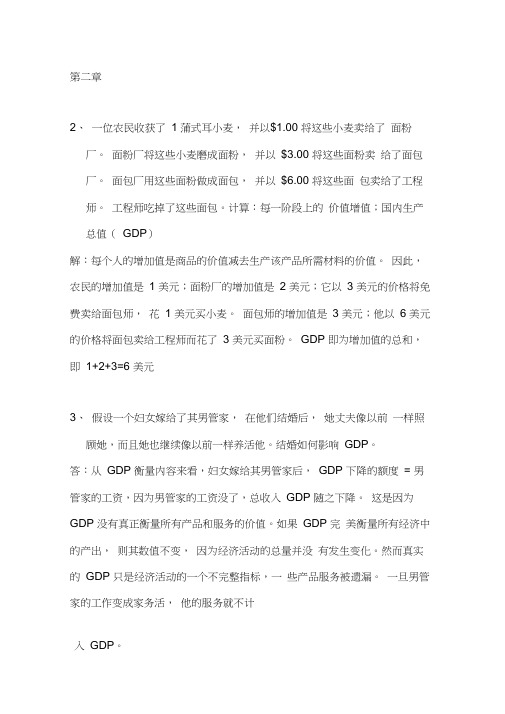
第二章2、一位农民收获了1 蒲式耳小麦,并以$1.00 将这些小麦卖给了面粉厂。
面粉厂将这些小麦磨成面粉,并以$3.00 将这些面粉卖给了面包厂。
面包厂用这些面粉做成面包,并以$6.00 将这些面包卖给了工程师。
工程师吃掉了这些面包。
计算:每一阶段上的价值增值;国内生产总值(GDP)解:每个人的增加值是商品的价值减去生产该产品所需材料的价值。
因此,农民的增加值是1 美元;面粉厂的增加值是2 美元;它以3 美元的价格将免费卖给面包师,花1 美元买小麦。
面包师的增加值是3 美元;他以6 美元的价格将面包卖给工程师而花了3 美元买面粉。
GDP 即为增加值的总和,即1+2+3=6 美元3、假设一个妇女嫁给了其男管家,在他们结婚后,她丈夫像以前一样照顾她,而且她也继续像以前一样养活他。
结婚如何影响GDP。
答:从GDP 衡量内容来看,妇女嫁给其男管家后,GDP 下降的额度= 男管家的工资,因为男管家的工资没了,总收入GDP 随之下降。
这是因为GDP 没有真正衡量所有产品和服务的价值。
如果GDP 完美衡量所有经济中的产出,则其数值不变,因为经济活动的总量并没有发生变化。
然而真实的GDP 只是经济活动的一个不完整指标,一些产品服务被遗漏。
一旦男管家的工作变成家务活,他的服务就不计入GDP。
6、考虑一个生产并消费面包和汽车的经济。
下表中是两个不同年份的数据。
(1)以2000年作为基年,计算每年的名义GDP,实际GDP,GDP 平减指数以及像CPI这样的固定加权物价指数。
解:名义GDP2000= (P 汽车2000 *Q 汽车2000)+ (P 面包2000 *Q 面包2000)=10,000,000名义GDP2010二(P 汽车2010 *Q 汽车2010 )+(P面包2010 *Q 面包2010 )=15,200 ,000实际GDP2010=(P 汽车2000 *Q 汽车2010)+(P面包2000 *Q 面包2010 )=10,000 ,0002010 年隐含的价格平减指数二名义GDP2010/实际GDP2010*100=152CPI 2010 =[P 汽车2010 *Q 汽车2000)+( P 面包2010 *Q 面包2000 )]/[( P 汽车2000 *Q汽车2000)+ (P面包2000 *Q 面包2000 )]=1.6(2)在2000年到2010年之间,物价上涨了多少?比较拉斯拜尔指数和帕氏指数给出答案。
经济学原理曼昆课后答案chapter3
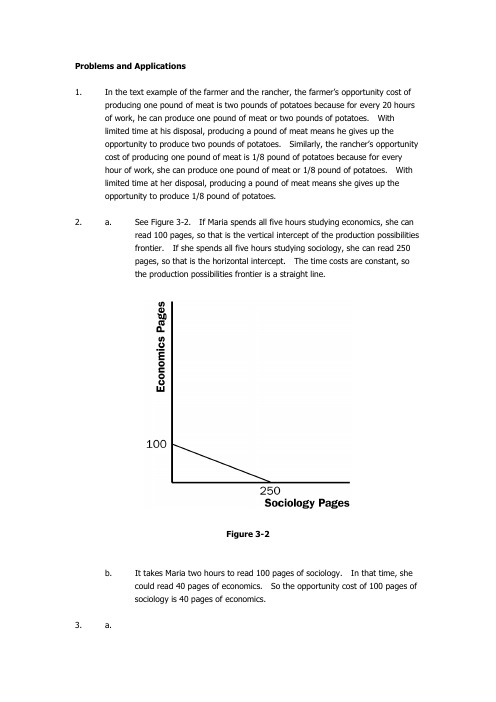
Problems and Applications1.In the text example of the farmer and the rancher, the farmer’s opportunity cost ofproducing one pound of meat is two pounds of potatoes because for every 20 hours of work, he can produce one pound of meat or two pounds of potatoes. Withlimited time at his disposal, producing a pound of meat means he gives up theopportunity to produce two pounds of potatoes. Similarly, the rancher’s opportunity cost of producing one pound of meat is 1/8 pound of potatoes because for everyhour of work, she can produce one pound of meat or 1/8 pound of potatoes. Withlimited time at her disposal, producing a pound of meat means she gives up theopportunity to produce 1/8 pound of potatoes.2. a.See Figure 3-2. If Maria spends all five hours studying economics, she canread 100 pages, so that is the vertical intercept of the production possibilitiesfrontier. If she spends all five hours studying sociology, she can read 250pages, so that is the horizontal intercept. The time costs are constant, sothe production possibilities frontier is a straight line.Figure 3-2b.It takes Maria two hours to read 100 pages of sociology. In that time, shecould read 40 pages of economics. So the opportunity cost of 100 pages ofsociology is 40 pages of economics.3. a.Workers needed to make:One Car One Ton of Grain U.S.1/41/10Japan1/41/5b.See Figure 3-3. With 100 million workers and four cars per worker, if eithereconomy were devoted completely to cars, it could make 400 million cars.Since a U.S. worker can produce 10 tons of grain, if the U.S. produced onlygrain it would produce 1,000 million tons. Since a Japanese worker canproduce 5 tons of grain, if Japan produced only grain it would produce 500million tons. These are the intercepts of the production possibilities frontiers shown in the figure. Note that since the tradeoff between cars and grain isconstant, the production possibilities frontier is a straight line.Figure 3-3c.Since a U.S. worker produces either 4 cars or 10 tons of grain, theopportunity cost of 1 car is 2½ tons of grain, which is 10 divided by 4.Since a Japanese worker produces either 4 cars or 5 tons of grain, theopportunity cost of 1 car is1 1/4 tons of grain, which is 5 divided by 4. Similarly, the U.S. opportunitycost of 1 ton of grain is 2/5 cars (4 divided by 10) and the Japaneseopportunity cost of 1 ton of grain is 4/5 cars (4 divided by 5). This gives the following table:Opportunity Cost of:1 Car (in terms of tons ofgrain given up)1 Ton of Grain (in termsof cars given up)U.S. 2 1/22/5Japan 1 1/44/5d.Neither country has an absolute advantage in producing cars, since they’reequally productive (the same output per worker); the U.S. has an absoluteadvantage in producing grain, since it’s more productive (greater output perworker).e.Japan has a comparative advantage in producing cars, since it has a loweropportunity cost in terms of grain given up. The U.S. has a comparativeadvantage in producing grain, since it has a lower opportunity cost in termsof cars given up.f.With half the workers in each country producing each of the goods, the U.S.would produce 200 million cars (that’s 50 million workers times 4 cars each)and 500 million tons of grain (50 million workers times 10 tons each).Japan would produce 200 million cars (50 million workers times 4 cars each)and 250 million tons of grain (50 million workers times 5 tons each).g.From any situation with no trade, in which each country is producing somecars and some grain, suppose the U.S. changed 1 worker from producingcars to producing grain. That worker would produce 4 fewer cars and 10additional tons of grain. Then suppose the U.S. offers to trade 7 tons ofgrain to Japan for 4 cars. The U.S. will do this because it values 4 cars at 10tons of grain, so it will be better off if the trade goes through. SupposeJapan changes 1 worker from producing grain to producing cars. Thatworker would produce 4 more cars and 5 fewer tons of grain. Japan willtake the trade because it values 4 cars at 5 tons of grain, so it will be betteroff. With the trade and the change of 1 worker in both the U.S. and Japan,each country gets the same amount of cars as before and both get additionaltons of grain (3 for the U.S. and 2 for Japan). Thus by trading and changingtheir production, both countries are better off.4. a.Pat’s opportunity cost of making a pizza is 1/2 gallon of root beer, since shecould brew 1/2 gallon in the time (2 hours) it takes her to make a pizza. Pathas an absolute advantage in making pizza since she can make one in twohours, while it takes Kris four hours. Kris’s opportunity cost of making apizza is 2/3 gallons of root beer, since she could brew 2/3 of a gallon in thetime (4 hours) it takes her to make a pizza. Since Pat’s opportunity cost ofmaking pizza is less than Kris’s, Pat has a comparative advantage in makingpizza.b.Since Pat has a comparative advantage in making pizza, she will make pizzaand exchange it for root beer that Kris makes.c.The highest price of pizza in terms of root beer that will make bothroommates better off is 2/3 gallons of root beer. If the price were higherthan that, then Kris would prefer making her own pizza (at an opportunitycost of 2/3 gallons of root beer) rather than trading for pizza that Pat makes.The lowest price of pizza in terms of root beer that will make bothroommates better off is 1/2 gallon of root beer. If the price were lower thanthat, then Pat would prefer making her own root beer (she can make 1/2gallon of root beer instead of making a pizza) rather than trading for rootbeer that Kris makes.5. a.Since a Canadian worker can make either two cars a year or 30 bushels ofwheat, the opportunity cost of a car is 15 bushels of wheat. Similarly, theopportunity cost of a bushel of wheat is 1/15 of a car. The opportunitycosts are the reciprocals of each other.b.See Figure 3-4. If all 10 million workers produce two cars each, theyproduce a total of 20 million cars, which is the vertical intercept of theproduction possibilities frontier. If all 10 million workers produce 30 bushelsof wheat each, they produce a total of 300 million bushels, which is thehorizontal intercept of the production possibilities frontier. Since thetradeoff between cars and wheat is always the same, the productionpossibilities frontier is a straight line.If Canada chooses to consume 10 million cars, it will need 5 million workersdevoted to car production. That leaves 5 million workers to produce wheat,who will produce a total of 150 million bushels (5 million workers times 30bushels per worker). This is shown as point A on Figure 3-4.c.If the United States buys 10 million cars from Canada and Canada continuesto consume 10 million cars, then Canada will need to produce a total of 20million cars. So Canada will be producing at the vertical intercept of theproduction possibilities frontier. But if Canada gets 20 bushels of wheat percar, it will be able to consume 200 million bushels of wheat, along with the10 million cars. This is shown as point B in the figure. Canada should acceptthe deal because it gets the same number of cars and 50 million morebushes of wheat.Figure 3-46.Though the professor could do both writing and data collection faster than thestudent (that is, he has an absolute advantage in both), his time is limited. If theprofessor’s comparative advantage is in writing, it makes sense for him to pay astudent to collect the data, since that’s the student’s comparative advantage.7. a.English workers have an absolute advantage over Scottish workers inproducing scones, since English workers produce more scones per hour (50vs. 40). Scottish workers have an absolute advantage over English workersin producing sweaters, since Scottish workers produce more sweaters perhour (2 vs. 1). Comparative advantage runs the same way. Englishworkers, who have an opportunity cost of 1/50 sweaters per scone (1sweater per hour divided by 50 scones per hour), have a comparativeadvantage in scone production over Scottish workers, who have anopportunity cost of 1/20 sweater per scone (2 sweaters per hour divided by40 scones per hour). Scottish workers, who have an opportunity cost of 20scones per sweater (40 scones per hour divided by 2 sweaters per hour),have a comparative advantage in sweater production over English workers,who have an opportunity cost of 50 scones per sweater (50 scones per hourdivided by 1 sweater per hour).b.If England and Scotland decide to trade, Scotland will produce sweaters andtrade them for scones produced in England. A trade with a price between20 and 50 scones per sweater will benefit both countries, as they’ll be gettingthe traded good at a lower price than their opportunity cost of producing thegood in their own country.c.Even if a Scottish worker produced just one sweater per hour, the countrieswould still gain from trade, because Scotland would still have a comparativeadvantage in producing sweaters. Its opportunity cost for sweaters wouldbe higher than before (40 scones per sweater, instead of 20 scones persweater before). But there are still gains from trade since England has ahigher opportunity cost (50 scones per sweater).8. a.Technological advance lowers the opportunity cost of producing meat for thefarmer. The opportunity cost of producing a point of meat was 2 pounds ofpotatoes; it’s now 1/5 pounds of potatoes. Thus the farmer’s opportunitycost of producing potatoes is now 5 pounds of meat. Since the rancher’sopportunity cost of producing potatoes is 8 pounds of meat, the farmer stillhas a comparative advantage in producing potatoes and the rancher still hasa comparative advantage in producing meat.b.Now the farmer won’t be willing to trade a pound of potatoes for 3 pounds ofmeat because if he produced one less pound of potatoes, he could produce 5more pounds of meat. So the trade would be bad for the farmer, as hewould then be consuming inside his production possibilities frontier.c.The farmer and rancher would now be willing to trade one pound of potatoesfor an amount between 5 and 8 pounds of meat, with the potatoes beingproduced by the farmer and the meat being produced by the rancher.9. a.With no trade, one pair of white socks trades for one pair of red socks inBoston, since productivity is the same for the two types of socks. The pricein Chicago is 2 pairs of red socks per pair of white socks.b.Boston has an absolute advantage in the production of both types of socks,since a worker in Boston produces more (3 pairs of socks per hour) than aworker in Chicago (2 pairs of red socks per hour or 1 pair of white socks perhour).Chicago has a comparative advantage in producing red socks, since theopportunity cost of producing a pair of red socks in Chicago is 1/2 pair ofwhite socks, while the opportunity cost of producing a pair of red socks inBoston is 1 pair of white socks. Boston has a comparative advantage inproducing white socks, since the opportunity cost of producing a pair ofwhite socks in Boston is 1 pair of red socks, while the opportunity cost ofproducing a pair of white socks in Chicago is 2 pairs of red socks.c.If they trade socks, Boston will produce white socks for export, since it hasthe comparative advantage in white socks, while Chicago produces red socksfor export, which is Chicago’s comparative advantage.d.Trade can occur at any price between 1 and 2 pairs of red socks per pair ofwhite socks. At a price lower than 1 pair of red socks per pair of whitesocks, Boston will choose to produce its own red socks (at a cost of 1 pair ofred socks per pair of white socks) instead of buying them from Chicago. Ata price higher than 2 pairs of red socks per pair of white socks, Chicago willchoose to produce its own white socks (at a cost of 2 pairs of red socks perpair of white socks) instead of buying them from Boston.10. a.The cost of all goods is lower in Germany than in France in the sense that allgoods can be produced with fewer worker hours.b.The cost of any good for which France has a comparative advantage is lowerin France than in Germany. Though Germany produces all goods with lesslabor, that labor is more valuable. So the cost of production, in terms ofopportunity cost, will be lower in France for some goods.c.Trade between Germany and France will benefit both countries. For eachgood in which it has a comparative advantage, each country should producemore goods than it consumes, trading the rest to the other country. Totalconsumption will be higher in both countries as a result.11. a.True; two countries can achieve gains from trade even if one of the countrieshas an absolute advantage in the production of all goods. All that’snecessary is that each country have a comparative advantage in some good.b.False; it is not true that some people have a comparative advantage ineverything they do. In fact, no one can have a comparative advantage ineverything. Comparative advantage reflects the opportunity cost of onegood or activity in terms of another. If you have a comparative advantagein one thing, you must have a comparative disadvantage in the other thing.c.False; it is not true that if a trade is good for one person, it can’t be good forthe other one. Trades can and do benefit both sides especially tradesbased on comparative advantage. If both sides didn’t benefit, trades wouldnever occur.。
曼昆《经济学原理》第6版微观经济学分册第4章课后习题答案P92-P94

曼昆《经济学原理》第6版微观经济学分册第4章课后习题答案P92-P94第一篇:曼昆《经济学原理》第6版微观经济学分册第4章课后习题答案P92-P94曼昆《经济学原理》微观经济学分册第4章课后习题答案P92-P94第二篇市场如何运作第四章供给与需求的市场力量复习题1.什么是竞争市场?简单描述除了完全竞争市场之外的市场类型。
答:竞争市场是有许多买者与卖者,以至于每个人对市场价格的影响都微乎其微的市场。
除了完全竞争市场之外,还有垄断市场。
在这个市场上只有一个卖者,他决定价格。
这个卖者被称为垄断者。
还有寡头市场,在这个市场上有几个并不总是主动竞争的卖者,他们提供相似或相同的产品。
通常情况下,寡头们会尽力联合起来,避免激烈的竞争,收取较高的市场价格。
还有垄断竞争市场,这是一个有许多提供相似但不相同产品的企业的市场结构。
由于各自提供的产品不同,每个企业对产品的价格都有一定的影响力。
2.什么是需求表和需求曲线?它们如何相关联?为什么需求曲线向右下方倾斜? 答:需求表是表示一种物品价格与需求量之间关系的表格,需求曲线是表示一种物品价格与需求量之间关系的图形。
需求曲线将需求表用图形的形式表现出来,需求表是需求曲线上若干个点的坐标的数字表格排列。
需求曲线向右下方倾斜是因为在其他条件不变的情况下,随着价格上升,需求量会减少。
3.消费者嗜好的变化引起了沿着需求曲线的变动,还是需求曲线的移动,价格的变化引起了沿着需求曲线的变动,还是需求曲线的移动? 答:消费者嗜好的变化引起了需求曲线的移动,价格的变化引起了沿着需求曲线的变动。
4.Popeye的收入减少了,结果他买了更多的菠菜。
菠菜是低档物品,还是正常物品? Popeye菠菜的需求曲线是什么样的? 答:菠菜对波匹来说是低档物品。
因为Popeye的收入减少了,他对菠菜的需求量反而增大。
波匹菠菜的需求曲线是向右下方倾斜的。
5.什么是供给表和供给曲线,它们如何关联?为什么供给曲线向石上方倾斜? 答:供给表是表示一种物品价格与供给量之间关系的表格,供给曲线是表示一种物品价格与供给量之间关系的图形。
(完整版)曼昆宏观经济学原理答案
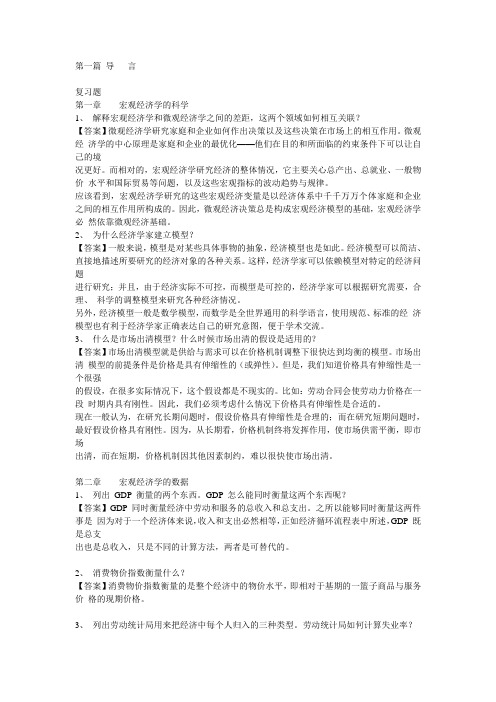
第一篇导言复习题第一章宏观经济学的科学1、解释宏观经济学和微观经济学之间的差距,这两个领域如何相互关联?【答案】微观经济学研究家庭和企业如何作出决策以及这些决策在市场上的相互作用。
微观经济学的中心原理是家庭和企业的最优化——他们在目的和所面临的约束条件下可以让自己的境况更好。
而相对的,宏观经济学研究经济的整体情况,它主要关心总产出、总就业、一般物价水平和国际贸易等问题,以及这些宏观指标的波动趋势与规律。
应该看到,宏观经济学研究的这些宏观经济变量是以经济体系中千千万万个体家庭和企业之间的相互作用所构成的。
因此,微观经济决策总是构成宏观经济模型的基础,宏观经济学必然依靠微观经济基础。
2、为什么经济学家建立模型?【答案】一般来说,模型是对某些具体事物的抽象,经济模型也是如此。
经济模型可以简洁、直接地描述所要研究的经济对象的各种关系。
这样,经济学家可以依赖模型对特定的经济问题进行研究;并且,由于经济实际不可控,而模型是可控的,经济学家可以根据研究需要,合理、科学的调整模型来研究各种经济情况。
另外,经济模型一般是数学模型,而数学是全世界通用的科学语言,使用规范、标准的经济模型也有利于经济学家正确表达自己的研究意图,便于学术交流。
3、什么是市场出清模型?什么时候市场出清的假设是适用的?【答案】市场出清模型就是供给与需求可以在价格机制调整下很快达到均衡的模型。
市场出清模型的前提条件是价格是具有伸缩性的(或弹性)。
但是,我们知道价格具有伸缩性是一个很强的假设,在很多实际情况下,这个假设都是不现实的。
比如:劳动合同会使劳动力价格在一段时期内具有刚性。
因此,我们必须考虑什么情况下价格具有伸缩性是合适的。
现在一般认为,在研究长期问题时,假设价格具有伸缩性是合理的;而在研究短期问题时,最好假设价格具有刚性。
因为,从长期看,价格机制终将发挥作用,使市场供需平衡,即市场出清,而在短期,价格机制因其他因素制约,难以很快使市场出清。
曼昆微观经济学(第三版)课后习题答案
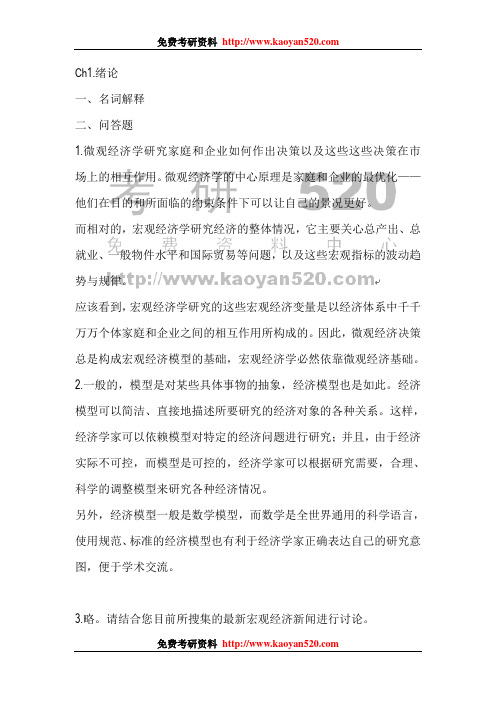
Ch1.绪论一、名词解释二、问答题1.微观经济学研究家庭和企业如何作出决策以及这些这些决策在市场上的相互作用。
微观经济学的中心原理是家庭和企业的最优化——他们在目的和所面临的约束条件下可以让自己的景况更好。
而相对的,宏观经济学研究经济的整体情况,它主要关心总产出、总就业、一般物件水平和国际贸易等问题,以及这些宏观指标的波动趋势与规律。
应该看到,宏观经济学研究的这些宏观经济变量是以经济体系中千千万万个体家庭和企业之间的相互作用所构成的。
因此,微观经济决策总是构成宏观经济模型的基础,宏观经济学必然依靠微观经济基础。
2.一般的,模型是对某些具体事物的抽象,经济模型也是如此。
经济模型可以简洁、直接地描述所要研究的经济对象的各种关系。
这样,经济学家可以依赖模型对特定的经济问题进行研究;并且,由于经济实际不可控,而模型是可控的,经济学家可以根据研究需要,合理、科学的调整模型来研究各种经济情况。
另外,经济模型一般是数学模型,而数学是全世界通用的科学语言,使用规范、标准的经济模型也有利于经济学家正确表达自己的研究意图,便于学术交流。
3.略。
请结合您目前所搜集的最新宏观经济新闻进行讨论。
4.市场出清模型就是供给与需求可以在价格机制调整下很快达到均衡的模型。
市场出清模型的前提条件是价格是具有伸缩性的(或弹性)。
但是,我们知道,价格具有伸缩性是一个很强的假设,在很多实际情况下,这个假设都是不现实的。
比如:劳动合同会使劳动力价格在一段时期内具有刚性。
因此,我们必须考虑什么情况下价格具有伸缩性是合适的。
现在一般地认为,在研究长期问题时,假设价格具有伸缩性是合理的;而在研究短期问题时,最好假设价格具有刚性。
因为,从长期看,价格机制终将发挥作用,使市场供需平衡,即市场出清,而在短期,价格机制因其他因素制约,难以很快使市场出清。
5.一般的,人们认为科学的定义是:一种建立稳定关系的科学的研究方法。
比如:物理学家可以通过实验来收集数据,证明或推翻一个假设。
经济学基础(曼昆)课后习题答案

第一章经济学十大原理一、为每个关键术语选择一个定义关键术语定义--------------稀缺性1、在社会成员中平等地分配利益的特征--------------经济学2、市场不能有效的配置资源的状况--------------效率3、有限的资源和无限的欲望--------------平等4、一个工人一小时所生产的物品与劳务量--------------理性5、市场上只有一个买者的情况--------------机会成本6、利己的市场参与者可以不知不觉的使整体社会福利最大化的原理--------------边际变动7、社会从其稀缺资源中得到最多东西的特性--------------激励8、社会和企业在市场上的相互交易决定资源配置的经济--------------市场经济9、经济活动的波动--------------产权10、当一个人的行为对旁观者有影响时的情况--------------“看不见的手”11、物价总水平的上升--------------市场失灵12、对现行计划的增量调整--------------外部性13、研究社会如何管理其稀缺资源--------------市场势力14、得到某种东西所放弃的东西--------------垄断15、一个人或一群人不适当的影响市场价格的能力--------------生产率16、某种引起人行动的东西--------------通货膨胀17、一个人拥有并使用稀缺资源的能力--------------经济周期18、为了达到目标而尽可能系统性的做到最好二、判断正误--------------1、当政府用税收和福利再分配收入时,经济变得更有效率。
-------------2、当经济学家说“天下没有免费的午餐”时,他们是指所有经济决策都涉及权衡取舍。
-------------3、亚当斯密的“看不见的手”的概念描述了公司经营如何像一只“看不见的手”伸到消费者的钱包中。
曼昆《经济学原理(微观经济学分册)》(第6版)课后习题详解(第3章 相互依存性与贸易的好处)
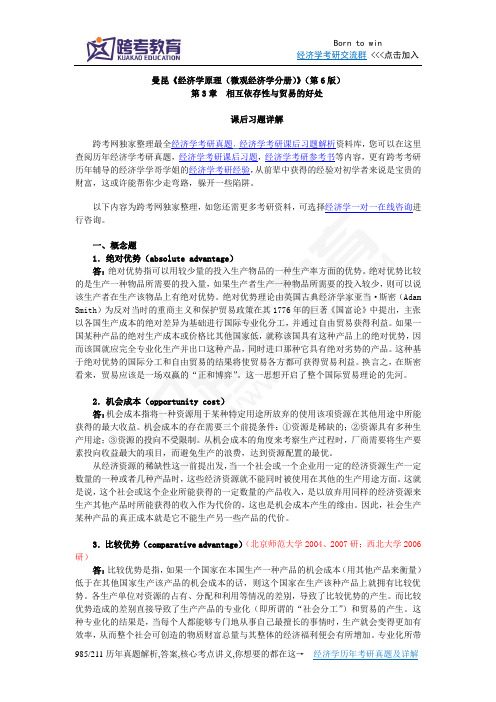
曼昆《经济学原理(微观经济学分册)》(第6版)第3章相互依存性与贸易的好处课后习题详解跨考网独家整理最全经济学考研真题,经济学考研课后习题解析资料库,您可以在这里查阅历年经济学考研真题,经济学考研课后习题,经济学考研参考书等内容,更有跨考考研历年辅导的经济学学哥学姐的经济学考研经验,从前辈中获得的经验对初学者来说是宝贵的财富,这或许能帮你少走弯路,躲开一些陷阱。
以下内容为跨考网独家整理,如您还需更多考研资料,可选择经济学一对一在线咨询进行咨询。
一、概念题1.绝对优势(absolute advantage)答:绝对优势指可以用较少量的投入生产物品的一种生产率方面的优势。
绝对优势比较的是生产一种物品所需要的投入量,如果生产者生产一种物品所需要的投入较少,则可以说该生产者在生产该物品上有绝对优势。
绝对优势理论由英国古典经济学家亚当·斯密(Adam Smith)为反对当时的重商主义和保护贸易政策在其1776年的巨著《国富论》中提出,主张以各国生产成本的绝对差异为基础进行国际专业化分工,并通过自由贸易获得利益。
如果一国某种产品的绝对生产成本或价格比其他国家低,就称该国具有这种产品上的绝对优势,因而该国就应完全专业化生产并出口这种产品,同时进口那种它具有绝对劣势的产品。
这种基于绝对优势的国际分工和自由贸易的结果将使贸易各方都可获得贸易利益。
换言之,在斯密看来,贸易应该是一场双赢的“正和博弈”。
这一思想开启了整个国际贸易理论的先河。
2.机会成本(opportunity cost)答:机会成本指将一种资源用于某种特定用途所放弃的使用该项资源在其他用途中所能获得的最大收益。
机会成本的存在需要三个前提条件:①资源是稀缺的;②资源具有多种生产用途;③资源的投向不受限制。
从机会成本的角度来考察生产过程时,厂商需要将生产要素投向收益最大的项目,而避免生产的浪费,达到资源配置的最优。
从经济资源的稀缺性这一前提出发,当一个社会或一个企业用一定的经济资源生产一定数量的一种或者几种产品时,这些经济资源就不能同时被使用在其他的生产用途方面。
曼昆经济学原理第3、4篇练习
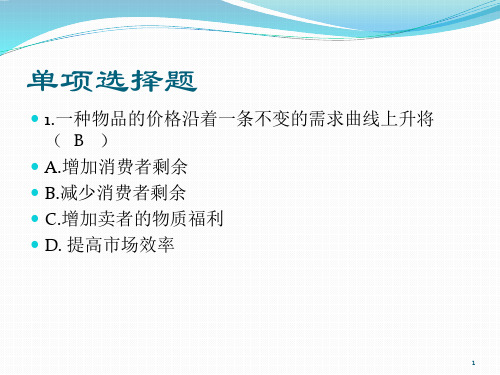
10
下表表示美国和加拿大一个工人每小时可以生产的产 量,根据该表回答
美国 加拿大
钢笔 8 8
铅笔 4 2
11.下列关于美国和加拿大之间自由贸易的表述正确的 是( C )
A.修复道路无效率 B.每户居民花3000美元修复自己家门前的那一段路
是有效率 C.政府向每户居民征收2000美元税并修复这条路是
有效率的 D.以上各项都不对
26
27. 以下属于公共资源的例子是 ( A ) A.国家公园 B.烟花表演 C.国防 D.铁矿
27
28. 当市场不能有效地配置资源时,问题的最终来源通 常是 ( C )
加了政府收入,并减少了总剩余 C.关税增加了生产者剩余,减少了消费者剩余,增
加了政府收入,并增加了总剩余 D.关税增加了消费者剩余,减少了生产者剩余,增
加了政府收入,并增加了总剩余
14
15.关于进口配额的表述,正确的是( C ) A.进口配额优于关税,因为他们使政府收入增加更多 B.出口国确定的自愿配额没有产生进口国的无谓损失 C.对每一种关税,都有一种可以引起相似结果的进口
20
21.Bob和Tom住在同一间大学宿舍里。Bob对大声放音 乐的评价为100美元,Tom对安静的评价为150美元。 以下表述正确的是 ( D )
A.Bob继续大声放音乐是有效率 B.只要Tom有安静的产权,Bob停止大声放音乐就是
有效率的
C.只要Bob有大声放音乐的产权,Bob停止大声放音 乐就是有效率的
4
5.如果一个市场是有效率的,那么( D ) A.市场把产量配置给了对他评价最高的买者 B.市场把买者配置给能以最低成本生产物品的生产者 C.市场生产的量是消费者和生产者剩余之和最大 D.以上各项都对 E.以上各项都不对
曼昆_微观经济学_原理_第五版_课后习题答案

第三篇市场和福利第十六章垄断竞争问题与应用1.在垄断、寡头、垄断竞争和完全竞争中,你如何给以下每一种饮料的市场分类:A.自来水B.瓶装水C.可乐D.啤酒答:·自来水市场是完全竞争市场,因为与许多水龙头,而且各个厂商的产品是无差异的。
·瓶装水市场是垄断竞争市场。
在这一市场上有许多生产瓶装水的厂商,而且每一厂商产出的瓶装水在品牌和包装上都有不同,即产品有一些差异。
·可乐市场是寡头市场。
在这一市场上只有有限的几家厂商控制大部分的市场分额。
·啤酒市场是寡头市场。
在这一市场上只有有限的几家厂商控制大部分的市场分额。
2.把下列市场分为完全竞争、垄断或垄断竞争,并解释你的回答。
A.2号木杆铅笔。
B.铜。
C.本地电话服务。
D.花生酱。
E.唇膏。
答:·花生酱市场是垄断竞争市场。
因为存在不同的质量特征和不同品牌。
·2 号铅笔、唇膏,属于垄断竞争市场。
因为市场有许多生产企业,但每个企业所提供的产品是略有不同的,而且企业可以自由进出市场。
·铜、本地电话服务,属于垄断市场。
因为在这两种市场上,只有惟一的一个生产者,而且产品没有相近替代品,其他企业想进入这个市场几乎是不可能的。
3.说出下面每一个特征描述的是完全竞争企业、垄断竞争企业,两者既是,还是两者都不是。
A.出售的产品与其竞争对手的产品有有差别答:该特征描述的是垄断竞争企业。
在垄断竞争市场上,企业出售与其竞争对手不同的产品。
B.边际收益低于价格答:该特征描述的是垄断竞争企业。
在垄断竞争市场上,企业边际收益低于价格。
C.在长期中获得经济利润答:该特征描述的既不是完全竞争企业,也不是垄断竞争企业。
在完全竞争和垄断竞争市场上,企业都不可能在长期中获得经济利润。
D.长期中生产最低平均总成本处的产量答:该特征描述的是完全竞争企业。
长期中,完全竞争市场中的企业生产最低平均总成本处的产量。
E.边际收益与边际成本相等答:该特征描述的既是完全竞争企业,也是垄断竞争企业。
微观 曼昆经济学原理-课后答案
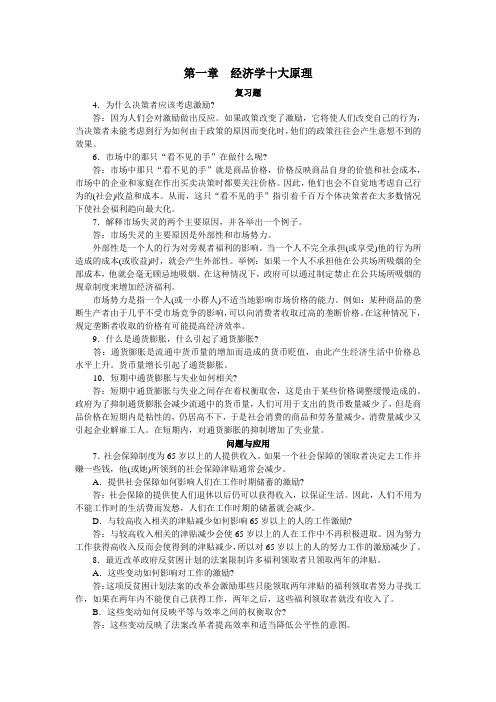
第一章经济学十大原理复习题4.为什么决策者应该考虑激励?答:因为人们会对激励做出反应。
如果政策改变了激励,它将使人们改变自己的行为,当决策者未能考虑到行为如何由于政策的原因而变化时,他们的政策往往会产生意想不到的效果。
6.市场中的那只“看不见的手”在做什么呢?答:市场中那只“看不见的手”就是商品价格,价格反映商品自身的价值和社会成本,市场中的企业和家庭在作出买卖决策时都要关注价格。
因此,他们也会不自觉地考虑自己行为的(社会)收益和成本。
从而,这只“看不见的手”指引着千百万个体决策者在大多数情况下使社会福利趋向最大化。
7.解释市场失灵的两个主要原因,并各举出一个例子。
答:市场失灵的主要原因是外部性和市场势力。
外部性是一个人的行为对旁观者福利的影响。
当一个人不完全承担(或享受)他的行为所造成的成本(或收益)时,就会产生外部性。
举例:如果一个人不承担他在公共场所吸烟的全部成本,他就会毫无顾忌地吸烟。
在这种情况下,政府可以通过制定禁止在公共场所吸烟的规章制度来增加经济福利。
市场势力是指一个人(或一小群人)不适当地影响市场价格的能力。
例如:某种商品的垄断生产者由于几乎不受市场竞争的影响,可以向消费者收取过高的垄断价格。
在这种情况下,规定垄断者收取的价格有可能提高经济效率。
9.什么是通货膨胀,什么引起了通货膨胀?答:通货膨胀是流通中货币量的增加而造成的货币贬值,由此产生经济生活中价格总水平上升。
货币量增长引起了通货膨胀。
10.短期中通货膨胀与失业如何相关?答:短期中通货膨胀与失业之间存在着权衡取舍,这是由于某些价格调整缓慢造成的。
政府为了抑制通货膨胀会减少流通中的货币量,人们可用于支出的货币数量减少了,但是商品价格在短期内是粘性的,仍居高不下,于是社会消费的商品和劳务量减少,消费量减少又引起企业解雇工人。
在短期内,对通货膨胀的抑制增加了失业量。
问题与应用7.社会保障制度为65岁以上的人提供收入。
如果一个社会保障的领取者决定去工作并赚一些钱,他(或她)所领到的社会保障津贴通常会减少。
曼昆《经济学原理》第6版 微观经济学分册 第3章 课后习题答案P63-P66
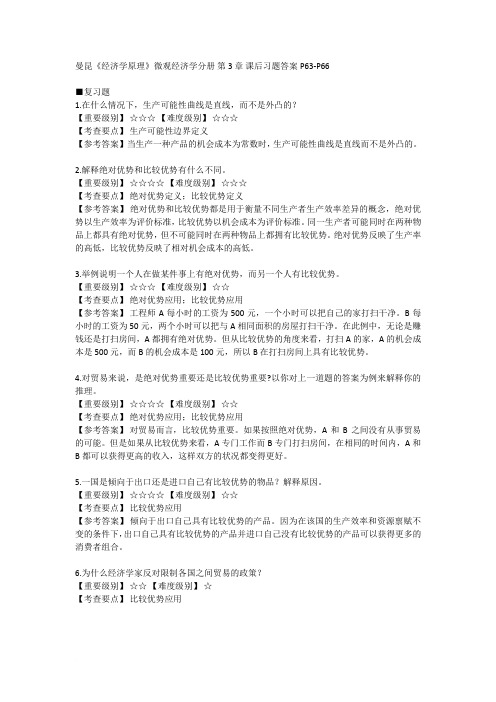
曼昆《经济学原理》微观经济学分册第3章课后习题答案P63-P66■复习题1.在什么情况下,生产可能性曲线是直线,而不是外凸的?【重要级别】☆☆☆【难度级别】☆☆☆【考查要点】生产可能性边界定义【参考答案】当生产一种产品的机会成本为常数时,生产可能性曲线是直线而不是外凸的。
2.解释绝对优势和比较优势有什么不同。
【重要级别】☆☆☆☆【难度级别】☆☆☆【考查要点】绝对优势定义;比较优势定义【参考答案】绝对优势和比较优势都是用于衡量不同生产者生产效率差异的概念,绝对优势以生产效率为评价标准,比较优势以机会成本为评价标准。
同一生产者可能同时在两种物品上都具有绝对优势,但不可能同时在两种物品上都拥有比较优势。
绝对优势反映了生产率的高低,比较优势反映了相对机会成本的高低。
3.举例说明一个人在做某件事上有绝对优势,而另一个人有比较优势。
【重要级别】☆☆☆【难度级别】☆☆【考查要点】绝对优势应用;比较优势应用【参考答案】工程师A每小时的工资为500元,一个小时可以把自己的家打扫干净。
B每小时的工资为50元,两个小时可以把与A相同面积的房屋打扫干净。
在此例中,无论是赚钱还是打扫房间,A都拥有绝对优势。
但从比较优势的角度来看,打扫A的家,A的机会成本是500元,而B的机会成本是100元,所以B在打扫房间上具有比较优势。
4.对贸易来说,是绝对优势重要还是比较优势重要?以你对上一道题的答案为例来解释你的推理。
【重要级别】☆☆☆☆【难度级别】☆☆【考查要点】绝对优势应用;比较优势应用【参考答案】对贸易而言,比较优势重要。
如果按照绝对优势,A和B之间没有从事贸易的可能。
但是如果从比较优势来看,A专门工作而B专门打扫房间,在相同的时间内,A和B都可以获得更高的收入,这样双方的状况都变得更好。
5.一国是倾向于出口还是进口自己有比较优势的物品?解释原因。
【重要级别】☆☆☆☆【难度级别】☆☆【考查要点】比较优势应用【参考答案】倾向于出口自己具有比较优势的产品。
- 1、下载文档前请自行甄别文档内容的完整性,平台不提供额外的编辑、内容补充、找答案等附加服务。
- 2、"仅部分预览"的文档,不可在线预览部分如存在完整性等问题,可反馈申请退款(可完整预览的文档不适用该条件!)。
- 3、如文档侵犯您的权益,请联系客服反馈,我们会尽快为您处理(人工客服工作时间:9:00-18:30)。
15
16.以下的观点没有用来支持贸易限制的是( D ) A.自由贸易摧毁了国内工作岗位 B.如果至关重要的物品是进口的,自由贸易就有损于
国家安全 C.如果外国补贴他们的出口行业,自由贸易就不利于
进口国 D.自由贸易既损害了国内生产者,又损害了国内消费
6
7.假设钻石的供给是相对无弹性的。对钻石征税将会 产生( D )
A.很大的无谓损失,而且税收负担将落在钻石的购 买者身上
B.很小的无谓损失,而且税收负担将落在钻石的购 买者身上
C.很大的无谓损失,而且税收负担将落在钻石的销 售者身上
D.很小的无谓损失,而且税收负担将落在钻石的销 售者身上
A.Bob将支付Tom 100美元,Bob将停止大声放音乐
B.Tom对Bob支付在100—150美元之间,Bob将停止 大声放音乐
C.Bob将支付Tom 150美元,Bob继续大声放音乐
D.Tom对Bob支付在100—150美元之间,Bob将继续 大声放音乐
22
23.污染的矫正税( A ) A.确定了污染的价格 B.确定了污染量 C.决定了污染权的需求 D.削弱了进一步减少污染的技术创新的激励
A.消费者将受益,而生产者将受损 B.生产者将受益,而消费者将受损 C.生产者和消费者都受益 D.生产者和消费者都受损
10
下表表示美国和加拿大一个工人每小时可以生产的产 量,根据该表回答
美国 加拿大
钢笔 8 8
铅笔 4 2
11.下列关于美国和加拿大之间自由贸易的表述正确的 是( C )
20
21.Bob和Tom住在同一间大学宿舍里。Bob对大声放音 乐的评价为100美元,Tom对安静的评价为150美元。 以下表述正确的是 ( D )
A.Bob继续大声放音乐是有效率 B.只要Tom有安静的产权,Bob停止大声放音乐就是
有效率的
C.只要Bob有大声放音乐的产权,Bob停止大声放音 乐就是有效率的
A.美国将出口铅笔,但在钢笔上没有贸易,因为没 有一个国家在钢笔的生产上有比较优势
B.美国将出口钢笔,而加拿大将出口铅笔 C.美国将出口铅笔,而加拿大将出口钢笔 D.美国既出口钢笔,又出口铅笔
11
12.当一国允许贸易并出口一种物品时,( D ) A.国内消费者状况变好,国内生产者状况变坏,而
A.价格没有高到使人们不过度消费 B.价格没有低到是企业不过度生产 C.没有很好地界定产权 D.政府管制
28
29. 一条拥挤的收费道路是( A ) A.私人物品 B.公共物品 C.公共资源 D.俱乐部产品
29
2
3.亚当·斯密“看不见的手”的概念表明,竞争市场的 结果( B )
A.使总剩余最小化 B.使总剩余最大化 C.引起社会成员的平等 D.B和C都对
3
4.如果买者是理性的,而且没有市场,那么( E ) A.自由市场解是有效率的 B.自由市场解是平等的 C.自由市场解使总剩余最大化 D.以上各项都是 E.A和C是正确的
A.修复道路无效率 B.每户居民花3000美元修复自己家门前的那一段路
是有效率 C.政府向每户居民征收2000美元税并修复这条路是
有效率的 D.以上各项都不对
26
27. 以下属于公共资源的例子是 ( A ) A.国家公园 B.烟花表演 C.国防 D.铁矿
27
28. 当市场不能有效地配置资源时,问题的最终来源通 常是 ( C )
D.无论谁有声音大小的产权,Bob停止大声放音乐都 是有效率的
21
22. Bob和Tom住在同一间大学宿舍里。Bob对大声放 音乐的评价为100美元,Tom对安静的评价为150美元。 如果Bob有大声放音乐的权利,而且,如果没有交易 成本,下列关于这个外部性问题有效解决的表述正确 的是( B )
单项选择题
1.一种物品的价格沿着一条不变的需求曲线上升将 (B )
A.增加消费者剩余 B.减少消费者剩余 C.增加卖者的物质福利 D. 提高市场效率
1
2.如果仁慈的社会计划者选择的生产量低于一种物品 的均衡数量,那么( D )
A.生产者剩余最大化 B.消费者剩余最大化 C.总剩余最大化 D.买者对生产的最后一单位的评价大于生产的成本 E.生产最后一单位的成本大于买者对它的评价
加了政府收入,并减少了总剩余 C.关税增加了生产者剩余,减少了消费者剩余,增
加了政府收入,并增加了总剩余 D.关税增加了消费者剩余,减少了生产者剩余,增
加了政府收入,并增加了总剩余
14
15.关于进口配额的表述,正确的是( C ) A.进口配额优于关税,因为他们使政府收入增加更多 B.出口国确定的自愿配额没有产生进口国的无谓损失 C.对每一种关税,都有一种可以引起相似结果的进口
18
19.当一个人在拥挤的城区买了一辆汽车时,这就引起 了( D )
A.有效率的市场结果 B.技术溢出效应 C.正外部性 D.负外部性
19
20.为了使正外部性内在化,适当的公共政策的反应应 该是 ( C )
A. 禁止生产引起外部性的物品 B. 政府生产物品直到增加一单位的价值为零 C.补贴这些物品 D.对物品征税
者,并减少了总剩余 E.自由贸易损害了进口国的幼稚产业
16
17.负外部性引起( A ) A.一种物品的社会成本曲线高于供给曲线(私人成本
曲线) B.一种物品的社会成本曲线低于供给曲线(私人成本
曲线) C.一种物品的社会价值曲线高于需求曲线(私人价值
曲线) D.以上各项都不是
17
18.(没有内在化的)正外部性引起 ( A ) A.最优数量大于均衡数量 B.均衡数量大于最优数量 C.均衡数量等于最优数量 D.均衡数量大于或小于最优数量
23
24.如果一个人消费一种物品减少了其他人对该物品的 使用,可以说这种物品是( C )
A.公共资源 B.由自然垄断生产的 C.竞争性的 D.排他性的
24
25.私人市场难以提供公共物品是由于( D ) A.公共物品问题 B.竞争性问题 C.公地悲剧 D.条路边的20家居民每家对修复道路的评价都 是3000美元。修复道路的成本是40000美元。下列表 述正确的是( C )
7
8.当一种物品税开始较低并逐渐增加时,税收收入 (C )
A.将增加 B.将减少 C.先增加后减少 D.先减少后增加
8
9.税收减少( A ) A.如果之前税收极高,可以增加税收收入 B.无论以前税收规模如何,总会减少税收收入 C.对税收收入没有影响 D.使市场变得更无效率
9
10.假定世界价格低于贸易前一种物品的国内价格。如 果一国允许这种物品的自由贸易,那么( A )
且一国由于输家的损失大于赢家的好处而变坏了 B.国内消费者状况变好,国内生产者状况变坏,而
且一国由于赢家的好处大于输家的损失而变好了 C.国内生产者状况变好,国内消费者状况变坏,而
且一国由于输家的损失大于赢家的好处而变坏了 D.国内生产者状况变好,国内消费者状况变坏,而
且一国由于赢家的好处大于输家的损失而变好了
4
5.如果一个市场是有效率的,那么( D ) A.市场把产量配置给了对他评价最高的买者 B.市场把买者配置给能以最低成本生产物品的生产者 C.市场生产的量是消费者和生产者剩余之和最大 D.以上各项都对 E.以上各项都不对
5
6.下列哪一种税会引起最大的无谓损失( C ) A.香烟税 B.盐税 C.旅游门票税 D.汽油税
12
13.当政治家认为戴尔电脑公司向印度外包技术支持会 有损美国经济时,他们运用的限制贸易观点的是 (B )
A.幼稚产业论 B.工作岗位论 C.国家安全论 D.无谓损失论
13
14.关于关税的表述,正确的是( A ) A.关税增加了生产者剩余,减少了消费者剩余,增
加了政府收入,并减少了总剩余 B.关税增加了消费者剩余,减少了生产者剩余,增
